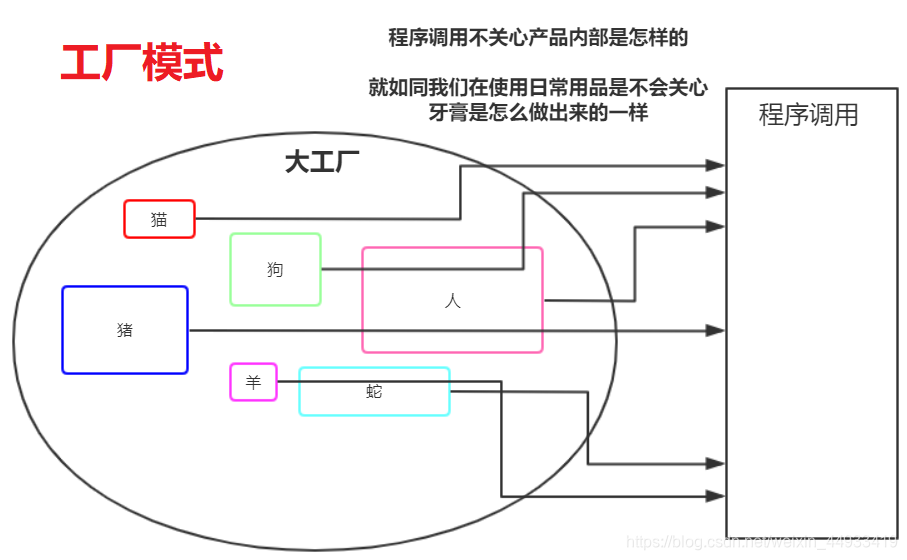
设计模式(二)—工厂模式(简单工厂模式)(附代码)
1、
2、
3、
4、
5、
6、
注:在Liunx环境下进行编译时,首先将这几个文件存放在同一个文件夹,然后需使用
发布日期:2021-05-04 19:13:21
浏览次数:10
分类:技术文章
本文共 2850 字,大约阅读时间需要 9 分钟。
一、什么是工厂模式?
是最常用的设计模式之一
这种类型的设计模式属于创建型模式,它提供了一种创建对象的最佳方式。
在工厂模式中,我们在创建对象时不会对客户端暴露创建逻辑,并且是通过使用一个共同的接口来指向新创建的对象。
二、工程模式简图

三、实例:
我们将实现输入对象名字,程序将根据对象姓名进行查找,查找完成在屏幕打印对象执行的动作,同时打印对象的姓名和年龄,若查找失败,则打印“no find name”
首先建立个5个.c文件和1个.h文件。如下:
1、Animal.h
该.h文件主要用于 类声明 以及几个 函数声明,同时可以将几个.C文件常用的.h文件包含于此。
#include#include /*“动物”类声明*/struct Animal{ /*成员属性*/ char name[128]; int age; int sex; int others; /*成员方法*/ void (*eat)(); void (*beat)(); void(*character)(); void (*test)(); struct Animal *next;};/*头插法建立链表函数声明*/struct Animal* putHeadDogLink(struct Animal* head);struct Animal* putHeadCatLink(struct Animal* head);struct Animal* putHeadHumanLink(struct Animal* head);/*根据名字检索对象函数声明*/struct Animal * findObjectName(char *name,struct Animal *head);/*“吃”函数声明*/void catEat();void dogEat();void humanEat();
2、Dog.c
#include"Animal.h"/*“狗”对象赋值*/struct Animal dog={ .name="lala", .age=5, .eat=dogEat};/*狗的eat函数*/void dogEat(){ printf("eat baba\n"); }/*头插法建立链表函数,若链表原来为空链表,则将dog作为链首*/struct Animal* putHeadDogLink(struct Animal* head){ if(head==NULL){ head=&dog; return head; }else{ dog.next=head; head=&dog; return head; } } 3、Cat.c
#include"Animal.h"/*“猫”对象赋值*/struct Animal cat={ .name="hihi", .age=2, .eat=catEat};/*猫的eat函数*/void catEat(){ printf("eat milk\n");}/*头插法建立链表函数,若链表原来为空链表,则将cat作为链首*/struct Animal* putHeadCatLink(struct Animal* head){ if(head==NULL){ head=&cat; return head; }else{ cat.next=head; head=&cat; return head; } } 4、Human.c
#include"Animal.h"/*“人”对象赋值*/struct Animal human={ .name="bobo", .age=18, .eat=humanEat};/*人的eat函数*/void humanEat(){ printf("eat rice\n");}/*头插法建立链表函数,若链表原来为空链表,则将human作为链首*/struct Animal* putHeadHumanLink(struct Animal* head){ if(head==NULL){ head=&human; return head; }else{ human.next=head; head=&human; return head; } } 5、Function.c
#include"Animal.h"/*根据名字检索对象函数,查找成功返回值为查到对象的地址,查找失败,返回NULL*/struct Animal * findObjectName(char *name,struct Animal *head){ struct Animal *tmp=head; /*判断链表是否为空链表*/ if(head==NULL){ printf("The list is empty\n"); return NULL; }else{ while(tmp!=NULL){ if(strcmp(tmp->name,name)==0){ return tmp; } tmp=tmp->next; } printf("no find name\n"); return NULL; }} 6、Main.c
#include "Animal.h"int main(){ char buf[128]={ '\0'}; struct Animal* head=NULL; struct Animal* tmp=NULL; /*头插法建立链表,将dog、cat、human三个对象组成链表*/ head=putHeadDogLink(head); head=putHeadCatLink(head); head=putHeadHumanLink(head); while(1){ /*清空buf*/ memset(buf,'\0',sizeof(buf)); printf("input name:\n"); scanf("%s",buf); /*根据名字检索对象函数,查找成功返回值为查到对象的地址,查找失败,返回NULL*/ tmp=findObjectName(buf,head); /*查找成功,将对象的姓名、年龄输出,同时执行对象的eat函数*/ if(tmp!=NULL){ tmp->eat(); printf("%s age:%d\n",tmp->name,tmp->age); } } return 0;} 注:在Liunx环境下进行编译时,首先将这几个文件存放在同一个文件夹,然后需使用gcc *.c
实验结果:

发表评论
最新留言
感谢大佬
[***.8.128.20]2025年03月16日 15时32分32秒
关于作者

喝酒易醉,品茶养心,人生如梦,品茶悟道,何以解忧?唯有杜康!
-- 愿君每日到此一游!
推荐文章
Java数据库开发
2019-03-01
第九章第六节(floyd算法多源有权最小路径)
2019-03-01
字符串反转
2019-03-01
数据库表设计-------三个范式
2019-03-01
夜光带你走走进全栈式web开发(25)擅长领域
2019-03-01
夜光带你走进Vue.js(三十二)擅长的领域
2019-03-01
夜光带你走进Vue.js(三十三)擅长的领域
2019-03-01
夜光带你走进JavaScript(五十二)擅长的领域
2019-03-01
夜光带你走进JavaScript(五十四)擅长的领域
2019-03-01
夜光带你走进JavaScript(五十五)擅长的领域
2019-03-01
Java工程师培训课(十三【可以坚持看完前十二章说明毅力尚可~~】)
2019-03-01
Java工程师培训课(十七【新的领域】)
2019-03-01
夜光带你走进 Ajax(四)
2019-03-01
夜光精讲 Opentcs 三大算法(二)任务分配算法
2019-03-01
夜光精讲 Opentcs 三大算法(十三)调度算法
2019-03-01
夜光精讲 Opentcs 通信系统
2019-03-01
夜光:基于 SpringMVC 框架的图片视频库系统的设计与实现 (一)
2019-03-01
夜光:计算机网络笔记(七)
2019-03-01
夜光带你走进 C语言(八十五)
2019-03-01
python作业之JSON数据的处理
2019-03-01